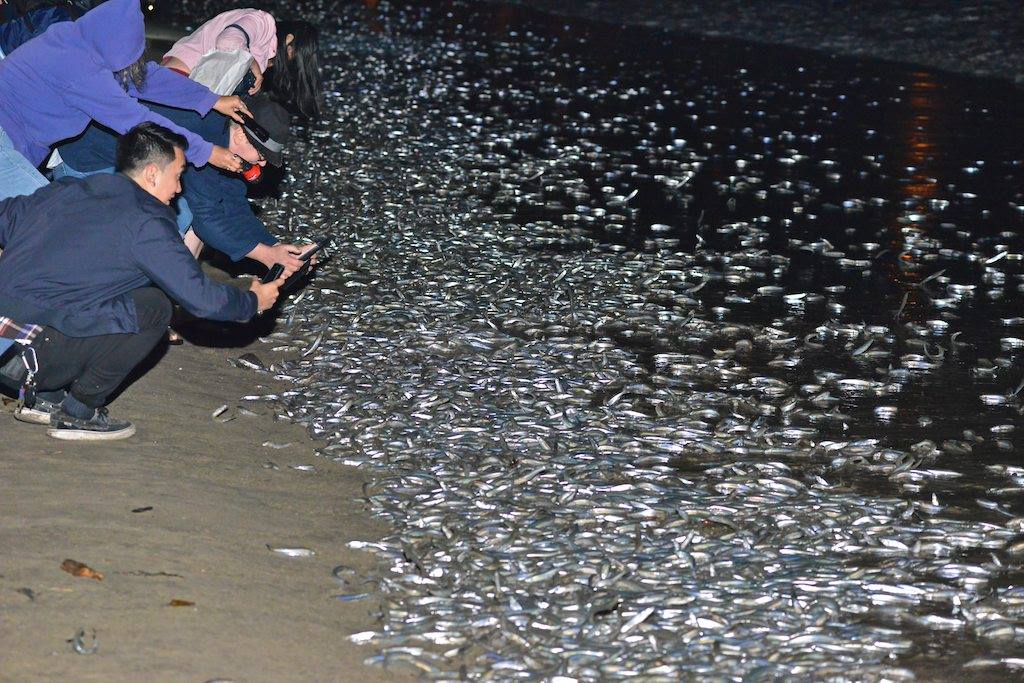
So you want to see a grunion run in 2023? Cool. First, let’s do a little refresher.
California Grunion are small, silvery fish that live off the coast of Southern California and northern Baja. On their own… yeah, they’re fine. But it’s the mating habits of these little guys that gets people excited every year.
During their late night spawning sessions, the grunion leave the water en masse to make the magic happen. Females twist themselves into the wet sand and deposit eggs into holes about 4 inches deep. Sometimes they’ll lay between 1,600 and 3,600 eggs in one evening. Males, meanwhile, flop around nearby and when the eggs are ready they’ll get close to the nest and release their milt, which in turn fertilizes the eggs. About 10 ten days later the newborns hatch, and if all goes well the tides wash the babies out to see. Circle of life!
Now, I’ve seen video of the runs. I’ve seen photos. I’ve attended meet-ups. I’ve stayed up late. But I’ve still never actually see a run happen in person. Maybe this will be the year?
For Los Angeles County residents, one of the best spots to catch the phenomenon is at Cabrillo Beach in San Pedro, although past runs have been observed in Malibu, Santa Monica, Venice, Hermosa Beach, and Belmont Shore. Peak season is usually late March to early June, and by August the runs tend to be more sporadic.
Note that as in years past, the Cabrillo Marine Aquarium has multiple ticketed events planned around the grunion season, including a Grunion Fish-Tival (April 21) where the aquarium is open for late-night hours with special activations, followed by a walk to the beach to see a run. There are also multiple Meet The Grunion events scheduled (April 7, May 21, June 19), which offer guided observation of (hopefully) a live spawn. Admission for any of these events is $7 for adults and $3 for students, seniors, and children.
If you’re thinking you want snatch a few grunion during a run, also remember that grunion may be taken by hand only and and California fishing license is required for people 16 and older. Also, you can’t dig holes as traps. And while there is no bag limit, it is recommended to take only the fish you can use.
As shown in the California Department of Fish & Wildlife expected schedule, the spawning sessions usually occur in four-day intervals during the arrival of the new and full moons. But remember that just because you show up at the specified time doesn’t mean you’ll witness the spawning. You’ll have to get lucky with the right night and the right beach, which makes it all a bit of a crapshoot.
If, however, you are absolutely committed to seeing the grunion this year, here are a few tips I pulled from straight from the the CDFW F.A.Q. page:
- Try to call the state and county beach lifeguards who can often inform you if spawning has taken place nearby. This could point you in the direction of which beach to stakeout.
- In general, the third and fourth nights of the interval give you the best chance to see a run. The time of the run will be 30 to 60 minutes past high tide and it will last from 1 to 3 hours. The heaviest part of the run usually occurs at least 1 hour after the run starts.
- The fish may get spooked easily by light, so use flashlights sparring when you’re observing. Uncrowded beaches are better, but it’s not prohibitive.
- Stay for the whole interval! Sometimes people leave after high tide and miss the run entirely.
Hope some of that helps. And happy grunioning!
March
* Where the forecast run starts at or after midnight, the date of the previous evening is shown.
- 3/7 Tuesday 9:40 p.m. – 11:40 p.m.
- 3/8 Wednesday 10:00 p.m. – 12:00 a.m.
- 3/9 Thursday 10:20 p.m. – 12:20 a.m.
- 3/10 Friday 10:45 p.m. – 12:45 a.m.
- 3/21 Tuesday 10:15 p.m. – 12:15 a.m.
- 3/22 Wednesday 10:45 p.m. – 12:45 a.m.
- 3/23 Thursday 11:15 p.m. – 1:15 a.m.
- 3/24 Friday 11:50 p.m. – 1:50 a.m.
April (observation only)
- 4/6 Thursday 10:10 p.m . – 12:10 a.m.
- 4/7 Friday 10:35 p.m. – 12:35 a.m.
- 4/8 Saturday 11:05 p.m. – 1:05 a.m
- 4/9 Sunday 11:40 p.m. – 1:40 a.m.
- 4/20 Thursday 10:05 p.m. – 12:05 a.m.
- 4/21 Friday 10:35 p.m. – 12:35 a.m.
- 4/22 Saturday 11:05 p.m. – 1:05 a.m.
- 4/23 Sunday 11:40 p.m. – 1:40 a.m.
May (observation only)
- 5/5 Friday 9:30 p.m. – 11:30 p.m.
- 5/6 Saturday 10:05 p.m. – 12:05 a.m.
- 5/7 Sunday 10:40 p.m. – 12:40 a.m.
- 5/8 Monday 11:20 p.m. – 1:20 a.m.
- 5/19 Friday 9:30 pm – 11:30 pm
- 5/20 Saturday 10:00 pm – Midnight
- 5/21 Sunday 10:35 pm – 12:35 am
- 5/22 Monday 11:10 pm – 1:10 am
June (observation only)
- 6/4 Sunday 9:45 p.m. – 11:45 p.m.
- 6/5 Monday 10:30 p.m. – 12:30 a.m.
- 6/6 Tuesday 11:20 p.m. – 1:20 a.m.
- 6/7 Wednesday 12:15 a.m. – 2:15 a.m.*
- 6/18 Sunday 9:45 pm – 11:45 pm
- 6/19 Monday 9:45 p.m. – 11:45 p.m.
- 6/5 Monday 10:30 p.m. – 12:30 a.m.
- 6/20 Tuesday 10:55 p.m. – 12:55 a.m
- 6/21 Wednesday 11:35 p.m. – 1:35 a.m.
July
- 7/3 Monday 9:40 p.m. – 11:40 p.m.
- 7/4 Tuesday 10:30 p.m. – 12:30 a.m.
- 7/5 Wednesday 11:15 p.m. – 1:15 a.m.
- 7/6 Thursday 12:10 a.m. – 2:10 a.m.*
- 7/17 Monday 9:35 p.m. – 11:30 p.m.
- 7/18 Tuesday 10:10 p.m. – 12:10 a.m.
- 7/19 Wednesday 10:40 p.m. – 12:40 a.m.
- 7/20 Thursday 11:15 p.m. – 1:15 a.m.
August
- 8/1 Tuesday 9:35 p.m. – 11:35 p.m.
- 8/2 Wednesday 10:20 p.m. – 12:20 a.m.
- 8/3 Thursday 11:10 p.m. – 1:10 a.m.
- 8/4 Friday Midnight – 2:00 a.m.*
- 8/16 Wednesday 9:55 p.m. – 11:55 p.m.
- 8/17 Thursday 10:25 p.m. – 12:25 a.m.
- 8/18 Friday 10:55 p.m. – 12:55 a.m.
- 8/19 Saturday 11:30 p.m. – 1:30 a.m.
For more information, please visit the California Department of Fish & Wildlife website.



